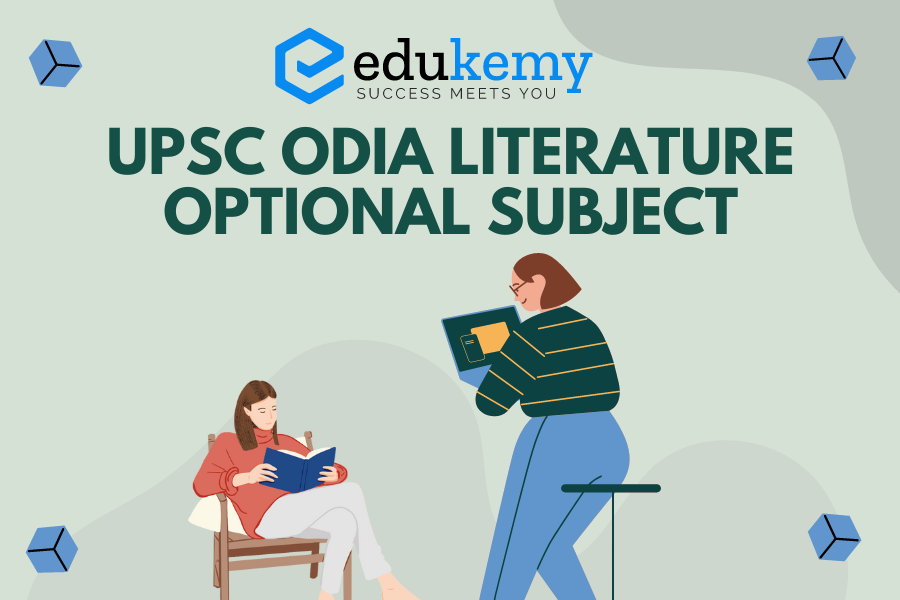
The UPSC Civil Services Examination offers Odia Literature as an optional subject for the Mains exam. Delving into the rich tapestry of Odisha’s literary heritage, this subject equips aspirants with a deep understanding of Odia’s linguistic roots, along with its evolution and diverse range of literary works. Through a structured study of poetry, prose, and drama, candidates gain valuable insights into the socio-cultural and historical landscape of Odisha, enriching their knowledge base for the UPSC exam.
Contents
Odia Paper 1
Section – A
(i) Origin and development of Odia Language—Influence of Austric, Dravidian, Perso— Arabic and English on Odia Language.
(ii) Phonetics and Phonemics: Vowels, Consonants Principles of changes in Odia sounds.
(iii) Morphology: Morphemes (free, bound compound and complex), derivational and inflectional affixes, case inflection, conjugation of verb.
(iv) Syntax: Kinds of sentences and their trans-formation, structure of sentences.
(v) Semantics—Different types of change in meaning. Euphemism.
(vi) Common errors in spellings, grammatical uses and construction of sentences.
(vii) Regional variations in Odia Language (Western, Southern and Northern Odia) and Dialects (Bhatri and Desia).
Section – B
(i) Historical backgrounds (social, cultural and political) of Odia Literature of different periods.
(ii) Ancient epics, ornate kavyas and padavalis.
(iii) Typical structural forms of Odia Literature (Koili, Chautisa, Poi, Chaupadi, Champu).
(iv) Modern trends in poetry, drama short story, novel essay and literary criticism.

Odia Paper 2
Section – A (Poems)
Ancient
- Sãralã Dãs—Shanti Parva from Mahãbhãrata.
- Jaganãth Dãs—Bhãgabata, XI Skadhã—Jadu Avadhuta Sambãda.
Medieval
- Dinakrushna Dãs—Raskallola—(Chhãndas—16 & 34)
- Upendra Bhanja—Lãvanyabati (Chhãndas—1 & 2).
Modern
- Rãdhãnath Rãy—Chandrabhãgã.
- Mãyãdhar Mänasinha—Jeevan—Chitã.
- Sãtchidananda Routray—Kabitã—1962.
- Ramãkãnta Ratha—Saptama Ritu.
Section – B
Drama:
- Manoranjan Dãs—Kätha-Ghoda.
- Bijay Mishra—Tata Niranjanä.
Novel:
- Fakir Mohan Senãpati—Chhamãna Ãthaguntha.
- Gopinãth Mohãnty—Dãnãpani.
Short Story:
- Surendra Mohãnty—Marãlara Mrityu.
- Manoj Dãs—Laxmira Abhisãra.
Essay:
- Chittaranjan Dãs—Tranga O Tadit (First Five essays).
- Chandra Sekhar Rath—Mun Satyadharmã Kahuchhi (First five essays).
5 FAQs on Odia Literature Optional Subject – UPSC
1. Who should consider Odia Literature as an Optional Subject?
- Students with a strong background in Odia language and literature.
- Candidates who have a genuine interest in Odia culture and literary heritage.
- Those comfortable reading and analyzing Odia literary works.
2. What are the advantages of choosing Odia Literature?
- Relatively less competition compared to some common optional subjects.
- Overlap with General Studies Paper I (Indian Heritage and Culture).
- Potential for scoring high marks with in-depth knowledge.
3. What does the UPSC syllabus for Odia Literature cover?
The syllabus is divided into two parts:
- Part A: History of Odia Literature (Early Medieval to Modern Period)
- Part B: Study of important literary works from different periods.
4. What are the resources available for preparation?
- Odia literature textbooks (in Odia and English)
- Previous years’ UPSC question papers
- Study materials from coaching institutes
- Literary criticism works on Odia literature (if available)
5. How to prepare for the Odia Literature Optional?
- Develop a strong foundation in Odia grammar and vocabulary.
- Read extensively from prescribed literary works and understand their context.
- Practice writing critical essays and answers in the exam format.
- Consider coaching guidance or group discussions for focused preparation.
In case you still have your doubts, contact us on 9811333901.
For UPSC Prelims Resources, Click here
For Daily Updates and Study Material:
Join our Telegram Channel – Edukemy for IAS
- 1. Learn through Videos – here
- 2. Be Exam Ready by Practicing Daily MCQs – here
- 3. Daily Newsletter – Get all your Current Affairs Covered – here
- 4. Mains Answer Writing Practice – here

